Inside Ukraine
A Country at War with Itself
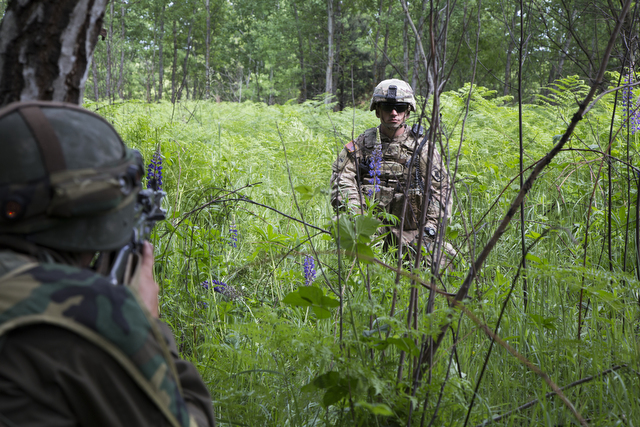
Jack Crosbie left his desk at The Santa Barbara Independent in 2013 to try to make it as a foreign correspondent, a goal he set while studying at UCSB. He covered the aftermath of Typhoon Haiyan for The Independent, before attending Columbia University’s Graduate School of Journalism. In May 2015, he traveled to Ukraine to cover the ongoing conflict there, primarily as a photojournalist. Since then, his pictures have appeared on Vice News, MailOnline, and other online outlets. He’s worked on both sides of the new border between the government-controlled Ukraine and the Russian-backed separatist Donetsk and Luhansk People’s Republics, as well as covering the United States’ training mission in the western part of the country. Here is his first-hand look at the current situation in Ukraine and what it’s like to live under the constant threat of war.
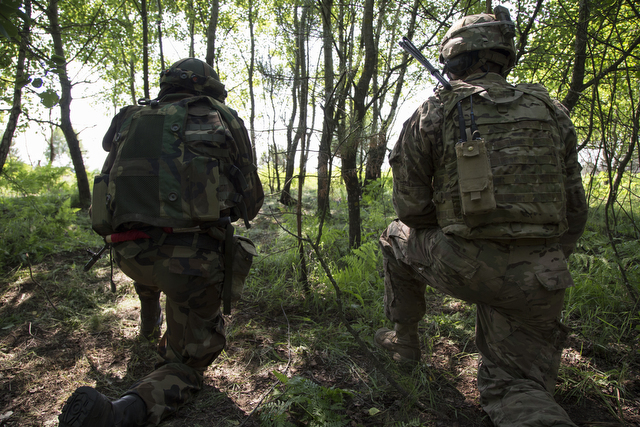
The beekeeper led me through the tangled remains of rebar and a wrought-iron gate, around the side of his house, skirting the pile of rubble that used to be his living room wall. In his backyard, he had half a dozen hives, honeybees lazily buzzing around them. A few of the hives were smashed. He popped open an intact one, prying off the wooden cover. Bees rose out, crawling on his bare face, diving in and out of the sheets of honeycomb inside. Some flew into the beekeeper’s fields, pollinating his crops — tomatoes, cucumbers, squash, strawberries, and snap peas that we ate right out of their pods. My two words of Russian did me little good, and his English wasn’t much better. My translator hadn’t arrived yet, so I followed the beekeeper through his fields communicating in gestures and staying close on his heels, wary of mines that soldiers might have dug into the soft earth. He took me back to the house, where he pulled out a jug of homemade vodka that he kept hidden from his wife, under a pile of newspapers. We chased down the fiery liquor with spoonfuls of honey, while a swallow flew laps around the living room, in through the broken window, out through the car-sized hole a tank shell had blown through the house this winter.
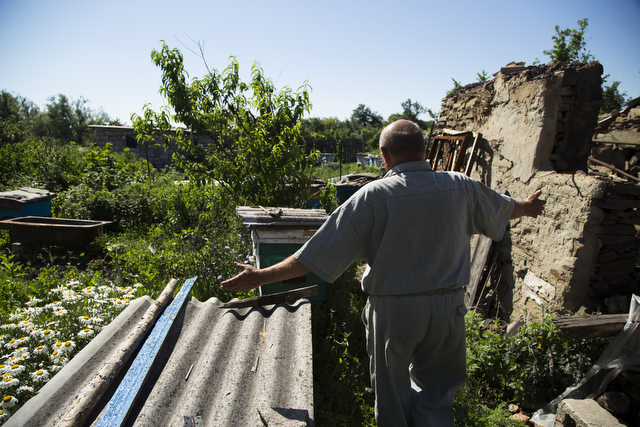
The beekeeper was lucky — his house still had three rooms relatively intact. Most of his town, Nikishyne, is completely leveled. It lies 60 kilometers northeast of Donetsk, the largest rebel-held city in Eastern Ukraine, and 12 kilometers from Hrabove, where Malaysia Airlines Flight 17 crashed last year. In late December, Nikishyne was caught between Russian-backed rebel forces loyal to the Donetsk People’s Republic and the Ukrainian army desperately trying to stop the rebels from advancing on the nearby town of Debaltseve, a major transport hub. Tanks, artillery, and infantry from both sides poured into Nikishyne, battling house-to-house down its main road and leveling everything in their path.
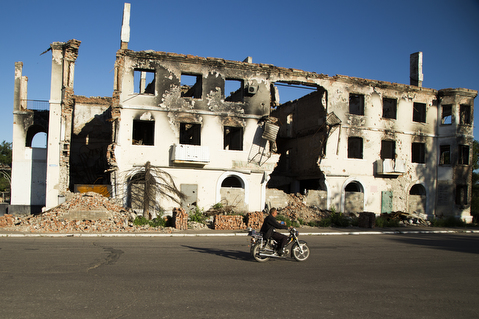
Nikishyne was the first town I’d seen in Ukraine with that degree of destruction. It wasn’t the last. The war in Eastern Ukraine has claimed 6,832 lives, as of August 1. The Internal Displacement Monitoring Centre estimates there are 1.3 million Internally Displaced People in Ukraine, civilians like those in Nikishyne who were forced to flee their homes when violence erupted.
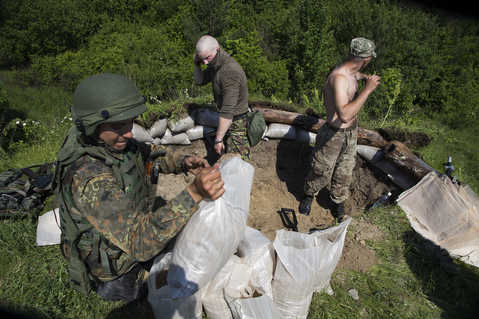
In case you haven’t read every report, here’s some ultra-condensed background: In February of 2014, protestors in Ukraine’s capital, Kiev, tossed out president Viktor Yanukovych after three months of clashes with police and government forces. Yanukovych’s government had changed the constitution to consolidate more power in the office of the president. Yanukovych wanted stronger ties with Vladimir Putin’s Russian Federation, and refused to sign agreements that would to bring Ukraine closer to the European Union. After Yanukovych’s ouster, the Russian Federation launched a shadow invasion and annexed the Crimean Peninsula, a prosperous and strategically important part of Ukraine, with a large ethnic-Russian population. In the east of the country, demonstrations against the new, post-Yanukovych Ukrainian government escalated into armed conflict, and pro-Russian rebels, led by soldiers wearing no insignia (i.e. Russians known as “little green men”) seized government buildings. The two major cities in the eastern Donbass region, Donetsk and Luhansk, declared themselves autonomous People’s Republics, and a full-fledged civil war erupted. Volunteer militias, some supporting separatist rebels, others loyal to a unified Ukraine, joined the fighting.
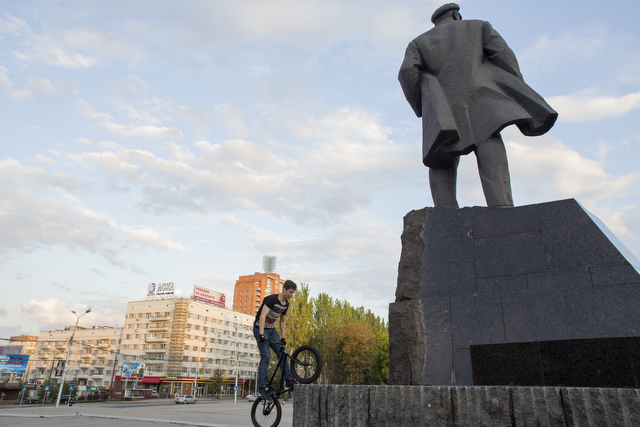
It’s strange, being in a country at war with itself. Ukraine is big, about 1,200 kilometers from east to west, and while the violence is largely consolidated in the Donbass region, the war is everywhere. In Kiev, where the population is split between native Russian and Ukrainian speakers, only Ukrainian is spoken in public. The Ukrainian trident symbol is flaunted on sequined T-shirts, flags, and bumper stickers and painted on the sides of buildings. Signs outside of restaurants read “NO SEPARATISTS ALLOWED.” Street vendors sell rolls of toilet paper with Vladimir Putin’s face emblazoned on them.
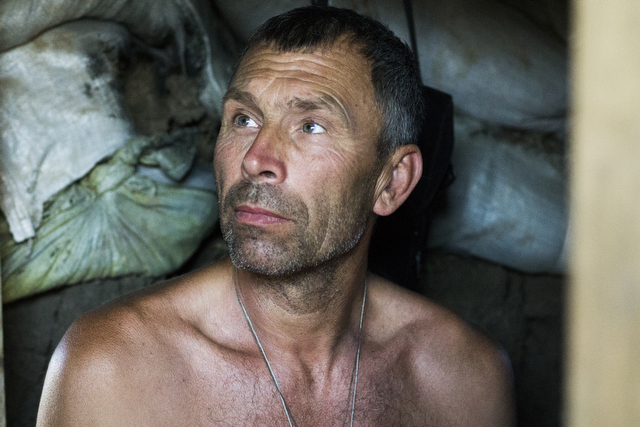
In recent months, the war has slowed down, no thanks to a largely ineffective ceasefire signed by Ukrainian, Russian, French, and German leaders in Minsk in February. Still, you only hear sporadic artillery barrages at night (when the OSCE, the international observers monitoring the conflict, aren’t on scene to witness who’s firing what), and the government is trying to rein in volunteer militias, such as the Azov and Donbass battalions, hoping to absorb them into formal National Guard units. In the western city of Lviv, 1,000 kilometers from the frontlines, members of the U.S. Army’s 173rd Airborne Brigade are training Ukrainian National Guard troops. Many of these paramilitary groups, however, embrace right wing, neo-Nazi ideologies and defy such inclusion. Their snipers and guerrilla units often go into combat zones without insignia, just as their declared enemy, the Russian “little green men,” did at the beginning of the war.
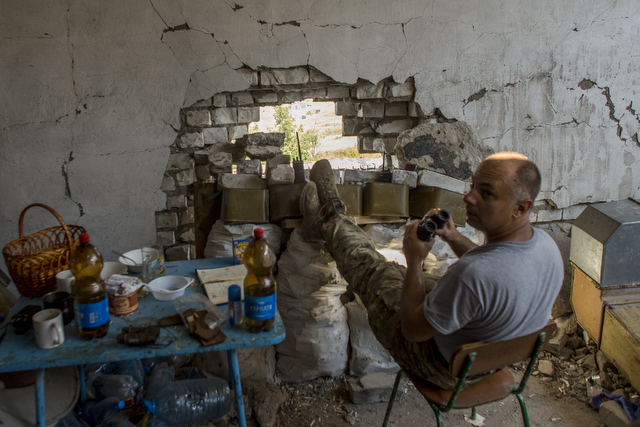
When Ukrainian and Donetsk People’s Republic leaders agreed to demilitarize the southern coastal town of Shyrokyne, pulling back their forces from the town, which had been obliterated earlier this spring, the pro-Ukrainian paramilitary units balked. I spent some time on the front line there, photographing fighters in the Donbass battalion, all of whom believed that the demilitarization was a trick to allow rebel forces to take more ground. “It’s pure blackmail,” said Anatoli Ovdeechook, a 52-year-old soldier who goes by ‘Viking.’ “We’ve lost too many men for that.” After an intense standoff, however, the Ukrainian Army troops were able to persuade the militia to stand down.
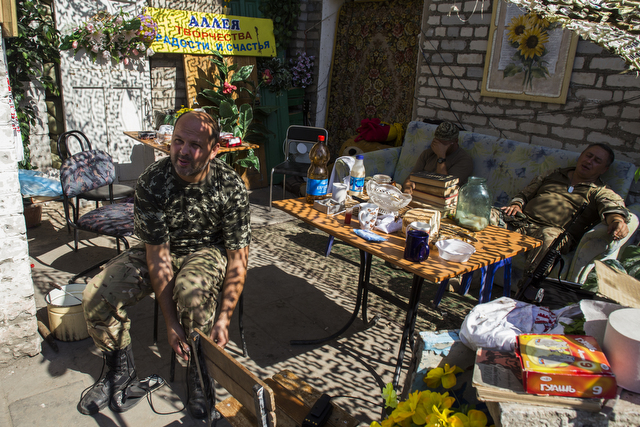
Between the Ukraine and the breakaway Donetsk People’s Republic runs an empty highway lined with a string of shattered towns and marked by a series of checkpoints, separated by a two-kilometer stretch of no man’s land. For civilians who have family on the other side of the lines, it’s an arduous journey. Car lines at the border checkpoints can last for hours, and bus service does not go through the buffer zone, so travelers, many of them elderly pensioners, have to disembark, walk through one checkpoint, cross the no man’s land, go through the next checkpoint, and then board another bus. There are constant passport checks, searches, and sometimes interrogations.
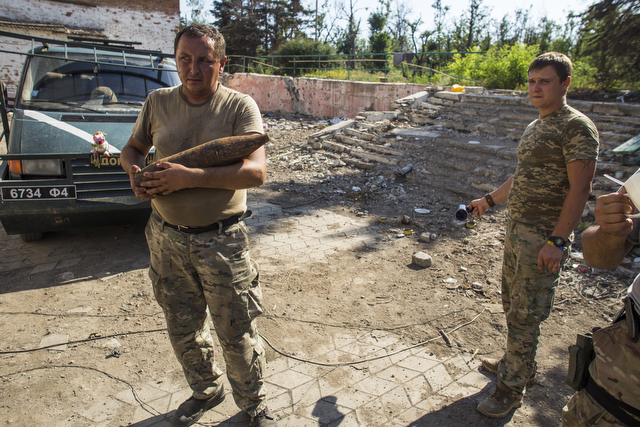
In late June, the first time I crossed over to the DPR, a firefight at the Volnovakha checkpoint shut down most of the border for the day. My driver and I waited in Mariupol for the night and ate dinner in a beachside café next to two Azov battalion soldiers, listening to the guns boom in the distance. The next day, we drove 100 kilometers north to Donetsk, the capital city of the Donetsk People’s Republic, hiding our Ukrainian press accreditations.

Before last winter’s heavy fighting, Donetsk had nearly a million inhabitants. Now, many have fled, and the streets are deserted when the 10 p.m. military curfew takes over. I’ve been living in Donetsk for the past month. It’s a surreal experience. One reporter captured the feeling, calling it a “five-star war.” The luxury hotels are all open, catering to Russian big shots, journalists (with bigger budgets than mine), and DPR military leaders. I rent a one-bedroom apartment that would cost well over $2,500 a month in Santa Barbara for $12 a night.
During the day, the city is beautiful, in a post-Soviet statues-of-Lenin sort of way. Soldiers and their girlfriends stroll around, eating ice cream cones and smoking hookah at cafés and restaurants. Families spend time down by the central river, fishing and picnicking. I learned to count in Russian by playing ping pong with a very serious group of older men who commandeer outdoor tables every evening. Over a year into the war, nobody even looks up when an armored vehicle rolls by or artillery fire booms from the closest frontline, 20 minutes away, near the destroyed airport, in the luxury suburb Pisky.
At night, after the curfew, the artillery picks up. It’s an unsettling feeling, lying on a comfortable bed in an air-conditioned apartment, listening to 152mm howitzers pound away. Recently, a shell crashed through the roof of a Donetsk hospital, killing one person and wounding another. Shells in the city center are rare, and an AP reporter on the scene told me that it was likely a 120mm mortar. If that’s true, there’s little chance Ukrainian troops could have fired it — the 120s only have a range of about seven and a half kilometers, and the Ukrainians are not within that radius. Knowledgeable locals speculated that the rebels might have fired the shell at their own city. It wouldn’t be the first time, they said. The DPR leadership jumps at any chance to remind its population that it is at war — patriotism and propaganda abound on the Ukrainian side, but the rhetoric reaches Orwellian levels in the DPR. In mid-July, a memorial ceremony for victims of the Malaysian Airlines Flight 17 became a propaganda event, when DPR leader Alexander Zakharchenko took the podium and accused the “Nazis in Kiev” of shooting down the plane — which was almost certainly shot by a rebel or Russian-controlled Buk missile launcher. Local villagers and civilians from Donetsk milled around in front of the international media waving DPR flags.
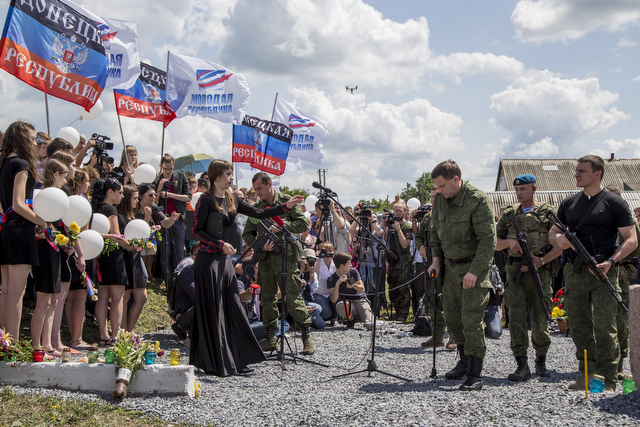
But on the front, in Nikishyne, Shyrokyne, Debaltseve, Avdiivka, and Pisky, towns ravaged by the violence, nobody watches TV. They might have their personal biases, but mostly they just wish for peace. At some point, the fact that your living room wall is gone becomes more important than who shot it out, especially if neither side will lift a finger to help you rebuild it. The conflict has died to a slow burn, smoldering at the outskirts of cities, flaring up to snatch a life here, a village there, and there’s no end in sight.



